Bill Wallace showing off the Volt cell and battery pack - Click above for high-res image gallery
On Monday, General Motors officially inaugurated the new Global Battery Systems test lab that was announced at the Detroit Auto Show in January. The lab, which GM claims is the largest such facility in the United States, greatly expands on the automaker's ability to test advanced energy storage cells, modules and full battery packs. The new facility has 33,000 square feet of floor space filled with battery cyclers, thermal chambers and even a shaker stand.
The new lab, which is four times the size of the old facility that was located within the research and development building at the Warren Tech Center, has moved to the Alternative Energy Center building on the same campus. The day's events began with a series of speeches by hybrid development director, Bob Kruse, CEO Fritz Henderson, and VP of global engineering Jim Queen along with a succession of federal, state and local politicians thanking themselves for helping to make this facility happen. Following the speeches we got to take a tour of the facility. Along the way we learned some new things about the Volt battery pack - all of which you can read about after the jump.
Photos Copyright ©2009 Sam Abuelsamid / Weblogs, Inc.
GM began planning its newly expanded battery lab back in December of 2007, about the time the first prototype packs for the Volt were hitting the test stands in the old lab. By August of 2008, construction had started and, according to VP of global engineering Jim Queen, the first cells started cycling in late January of this year. By the end of May, the lab was fully operational. The original lab - where the EV1 batteries and all the hybrid batteries had been developed - turned quiet.

The facility consists of two main test areas, one dedicated to cell and module testing and the other to full pack analysis. Over the last several years, GM has developed a four phase process for evaluating potential battery suppliers, part of which is manifested in these labs. Battery systems staff researcher Ramona Ying explained the process.
The first step is a pre-qualification phase where GM engineers evaluate the test and simulation data from the cell manufacturers as well as the packaging and other design elements. Packaging is an important element because GM, like other automakers, is avoiding the very small cells developed for consumer electronics. While these cells are available, using them greatly increases manufacturing complexity and opens up potential durability issues.
GM has made it clear that it is open to evaluating any energy storage system that suppliers can provide including both electrochemical cells and ultra-capacitors. Through this first phase of the process GM has evaluated more than 155 storage chemistries from 115 different suppliers. More than 60 different chemistries have made it past that initial vetting process to actual lab testing. Over the years, GM has tested over 14,200 individual cells from 20 different suppliers.
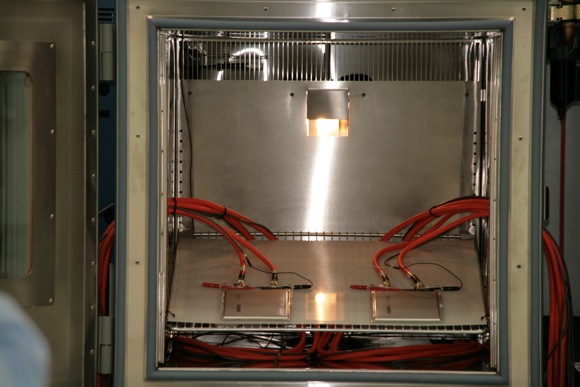
In the cell and module testing area there are 32 individual cyclers along with 16 smaller thermal chambers for exercising the individual units. GM runs the cells through a variety of different test cycles including the US06 cycle used by the EPA as well as cycles recorded from vehicle testing at the Milford Proving Ground and elsewhere. By running cells and modules through the cycles 24 hours a day, engineers are able to compress 10 years of running data into less than two years. Testing can be further accelerated by running at hot and cold temperature extremes including both sustained temperatures and transient conditions.
Across the corridor from the cell and module test lab is the pack test lab. Speaking of that corridor, GM expended some of its sustainability efforts on that as well. The hallway separating the two labs is lit entirely with energy efficient LEDs. The ceiling is made from recycled aluminum while the floor is covered with a rubber finish made from recycled tires. Hanging on the walls are panels describing the history of batteries and electric vehicles.
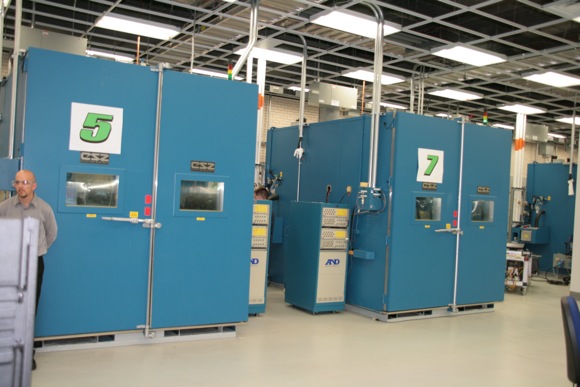
Over in the pack testing lab there are 20 battery cyclers charging and discharging packs for the Volt and other GM hybrid programs. The larger thermal chambers can hold up to four Volt battery packs at a time while the smaller chambers can accommodate two packs. When being tested in these chambers, the engineers can also add in other subsystems to check interactions. One chamber that was open included a pack plus the full cooling system, the in-vehicle charging system and other components.
So far, GM and CPI have built over 100 Volt packs for testing and, according to Engineering Group Manager Bill Wallace, the Volt pack design is on its fifth major design iteration. This current iteration is the production intent configuration. Unlike the earliest packs that had metal casings, the current design uses a casing made of sheet molding compound (SMC) similar to the material used for many of the Corvette's body panels.
The overall configuration and layout of the pack has remained unchanged. The internal changes are the result of testing and lessons learned about the thermal management, electronics and manufacturing issues. One of the interesting things that Wallace mentioned was that the various components that comprise the production intent pack have 150 unique part numbers. Of those, 147 were designed by GM and are proprietary.
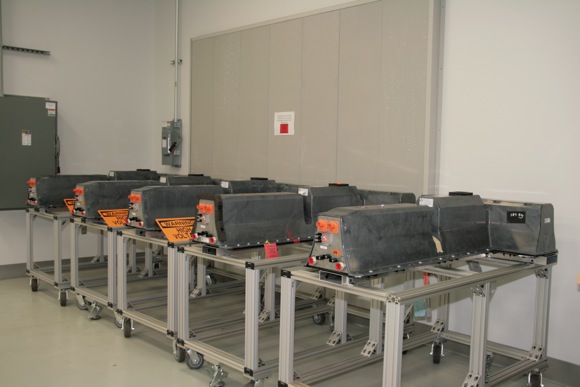
We asked GM battery director Denise Gray about this later and she explained that the first prototype packs were designed and built by Compact Power to GM's overall package dimensions. Over time, as the pack evolved and as a result of testing, GM engineers have reworked virtually the entire pack to meet the automaker's reliability, durability, performance and safety requirements. Of the three remaining parts not designed by GM, one is the LG Chem cells.
We've not previously seen the LG Chem cells for the Volt up close but when we saw one on the table in the lab, it looked familiar. It turns out that the Volt cell is very similar to those being supplied by LG Chem to Hyundai for its new hybrids. Wallace referred to the cell as a lithium ion polymer which we haven't previously heard mentioned by GM. Gray told us that the Volt cells are based on the same technology that LG Chem developed for Hyundai. That's one of the reasons that LG Chem was able to deliver its first prototype packs several months before Continental and A123 Systems in late 2007.
The packaging and basic technology of the Volt and Hyundai cells is the same. However, the chemistries differ, with the Volt being biased towards more energy density while the Hyundai cells (destined for a parallel hybrid) are balanced toward power density. The Volt cells have a rated energy density of 150 Wh/kg, among the highest in the industry and have a voltage of 3.5V per cell. Wallace and Gray would only acknowledge that there are between 200 and 300 cells in the pack without getting more specific at this time. The complete pack weighs in at about 400 pounds and GM expects to have 300 complete packs by the end of September.
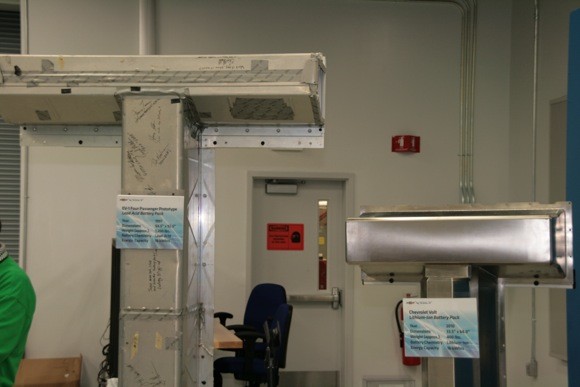
The big production ramp-up will begin this summer when GM starts production at its battery pack assembly facility. That factory will start up this August but Vice-Chairman Tom Stephens, VP Jon Laukner and Gray all replied "we're not ready to announce that yet" when queried as to the location.
In addition to the testing going on in the lab, there is plenty of testing going on at the track. One of the typical durability tests done on new vehicles is driving through a water trough and partially submerging the vehicle. The Volt will also be subjected to this and the pack is almost completely submerged. According to Wallace, the pack is capable of being completely underwater without a safety issue.
Back in the test lab, charging and discharging batteries requires power and lots of it. When running at full capacity, the lab has a maximum draw of 6 MW, enough power for 1,400 homes. Some of that power will be coming from eight wind generators (six currently installed) mounted on the roof of the building. Most of the power used for testing is for charging the packs and cells. However, after charging the batteries are discharged and over 90 percent of the power is recycled and fed back into the grid, dramatically cutting overall power usage.

One of the other innovations implemented by GM in the new lab is a high degree of automation. When packs and cells are being cycled, there isn't actually much that needs to be done with them. As a result, the lab runs 24 hours a day 7 days a week, but it is only staffed on the day shift, Monday to Friday. The lab has a system called Lab Minder that can monitors all 160 test stands and can automatically notify personal in the event of a problem. The labs are filled with webcams allowing staff to check in remotely and they can log into the Lab Minder system and check on all the data for each cell. In an emergency, security personnel can take care of the problem. One of the main tasks of the engineers working on batteries at GM is data analysis. The automated test systems monitor a wide variety of parameters on every cell in the packs. When the lab is running at full capacity, the testers can generate more than 45 GB of data, every single day!
Getting back to that very first Volt battery pack that was delivered by CPI back in November 2007, just ten months after the Volt concept was revealed, it's still running on test. Since it was delivered, it has cycled through more than 7,100 kWh and it's still going. Assuming it is cycling through 8 kWh per charge, that's over 887 cycles and roughly 35,500 miles.
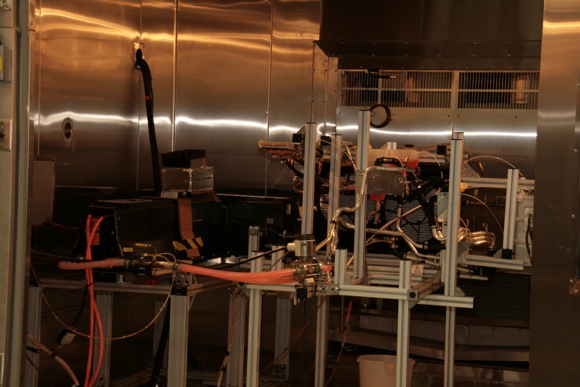
GM is willing to examine and test any electrical energy storage device a manufacturer brings to the lab. By testing in a common environment, GM can do solid comparisons of different technologies and share the resulting data with the supplier.
Photos Copyright ©2009 Sam Abuelsamid / Weblogs, Inc.
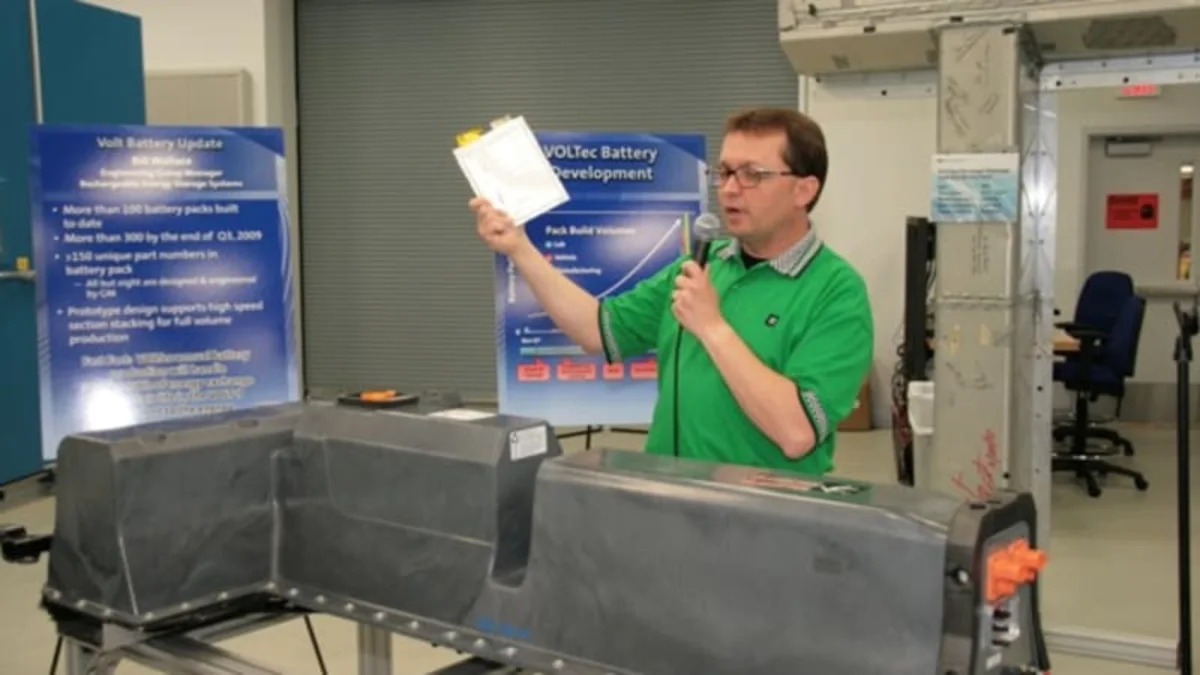
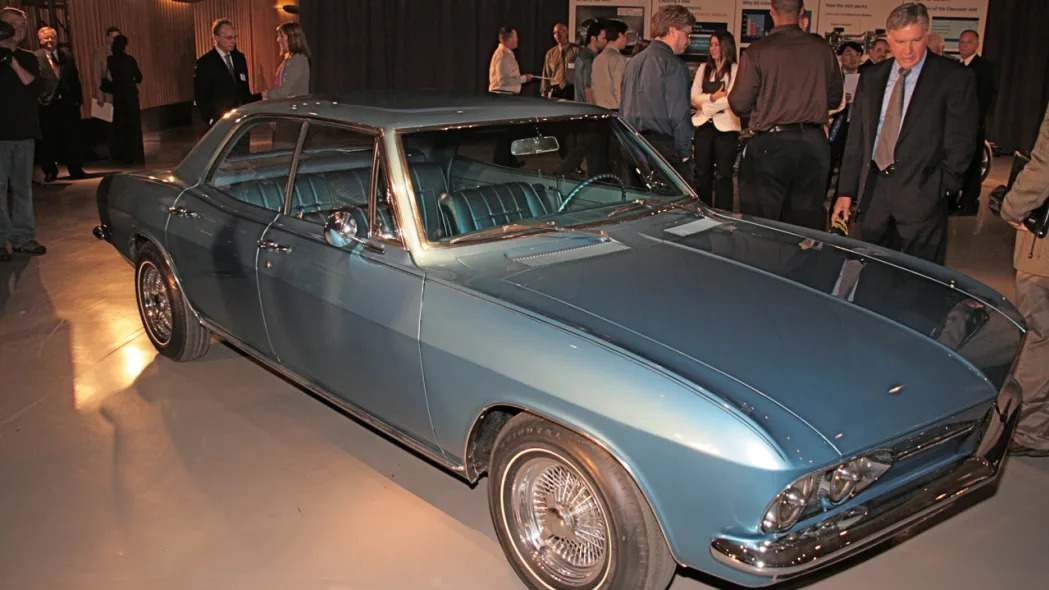

Sign in to post
Please sign in to leave a comment.
Continue